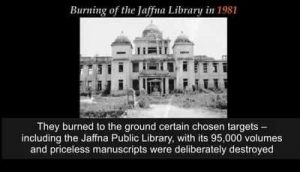“Those who cannot remember the past, are condemned to repeat it. – George Santayana”
JAFFNA PUBLIC LIBRARY
The Jaffna Public Library was the pride of invaluable asset of Tamil people, not only for those who lived in Jaffna peninsula, but also for academics and research-scholars from all around the world. With a modest beginning in 1933, it grew to become a repository of significant Tamil palm leaf manuscripts, original copies of regionally important historic documents in the contested political history of Sri Lanka and newspapers that were published hundreds of years ago in the Jaffna peninsula. It thus became a place of historic and symbolic importance to the Tamil people.
BURNING DOWN JAFFNA PUBLIC LIBRARY – A CULTURAL GENOCIDE
On 01 June 1981, Jaffna Public Library was reduced to ash by the premeditated willful and malicious act of then Sri Lankan government with the presence of two cabinet ministers Gamini Dissanayake and Cyril Matthew were stationed in Jaffna to oversee the election process and campaign. They abetted the police forces and thugs especially brought from south and housed in Duraiappa Stadium under the guise of election duty of the District Council election on June 04th. Duraiappa Stadium is situated right across a road of Jaffna Public Library is and was adjacent to the location of Jaffna Police Station; all were in the same bordering vicinity separated by a road; at that time.
At around 10pm on 01 June 1981, Jaffna’s then Municipal Commissioner Mr. C V K Sivagnanam received a call from Mrs Yogendra Duraisamy, the wife of then Government Agent of Jaffna District and their house was within the vicinity of the library, telling him that there were smoke and fire coming around the library and asked him to check up. When he contacted his staff over the phone, and they told him that the library has been set on fire.
Please find former Municipal Commissioner Mr C V K Sivagnanam’s testimony as video statement[1] (https://youtu.be/jzQ_6Wt0wew)
For Tamils, the devastated library became a symbol of cultural genocide. The attack was seen as an assault on their aspirations, the value of learning and traditions of academic achievement.
Thereafter, a committee was appointed by the President J R Jayawardena, and one-man committee was headed by Kingly Wickramasooriya, who was the DIG, came to Jaffna and collected evidence from several high-ranking officials and witnesses in Jaffna, including then Jaffna Municipal Commissioner Mr. C V K Sivagnanam, who was threatened to be shot by the police by a road barricade, when Mr. Sivagnanam was rushing in his car after receiving a phone call about Jaffna Library was on fire. Mr. Sivagnanam had seen the burning library and the policemen in the library area from the location where he was stopped by the police.

Despite of appointing a committee by the government at that time and up to now no action have been taken by any successive Sri Lankan government came to power thereafter, to grant justice to the heinous crime committed by the perpetrators by burning the cultural treasure of Tamil people.
This shows the clear evidence of Tamil genocidal intent of the Sri Lankan state’s policy that it hitherto continues.
TAMIL PEOPLE RIGORUSLY ENDEAVOURED TO RETAIN THE RUINED LIBRARY AS A MEMORIAL OF STRUCTURAL GENOCIDE OF TAMIL PEOPLES’ INVALUABLE INHERITANCE AND TO BUILD ANOTHER IDENTICAL ONE NEARBY
Nonetheless, their endeavor was shattered when subsequent Sri Lankan governments tacitly planned and refurbished the ruined Jaffna Library building with the motive of eradicating all evidence of their genocidal act. Despite the fascia of the library is restored, the acrimony of destroying irrecoverable invaluable manuscripts, original copies of historic documents and newspapers will continue to traumatise Tamil people as long as they live.
Tamil peoples’ will to retain and preserve the charred building as a living memory of structural genocide; a part of the atrocity crimes being continuously inflicted on them, has also been deliberately denied.

During one of the truce negotiations between Chandrika Kumaratunga’s government and the LTTE in 1994 – 95, the government of Sri Lanka purposely brought the issue of the Jaffna Public Library and a compromise was reached between the negotiating parties for a new library to be built next to the old one. Subsequently, an architectural design for the new library was submitted by the LTTE representatives to the government negotiators.
REFURBISHING & FURNISHING OF THE BURNT DOWN JAFFNA PUBLIC LIBRARY
Nevertheless, contrary to such a negotiated compromise to retain the burnt library building, President Chandrika Kumaratunga, after militarily occupying the Jaffna district in 1996, undertook to repair & refurbish the old library building, deliberately to erase the scars of the burnt library.
This has been the hallmark of the Sri Lankan state’s structural genocide with the notion of eliminating Tamil people and their historical invaluable records form Sri Lanka’s history. Its enduring psychological scar will continue to traumatise Tamil people as long as they live.

